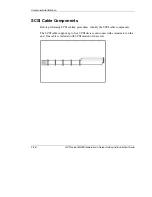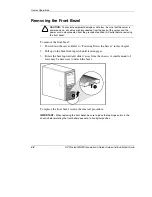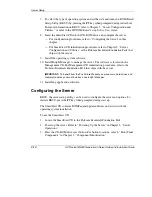
Server Setup
HP servers draw in cool air through the front door and expel warm air through the
rear door. Therefore, the front and rear rack doors must be adequately ventilated to
allow ambient room air to enter the cabinet, and the rear door must be adequately
ventilated to allow the warm air to escape from the cabinet.
CAUTION:
To prevent improper cooling and damage to the equipment, do not block
the ventilation openings.
When a vertical space in the rack is not filled by a server or rack component, the gaps
between the components cause changes in airflow through the rack and across the
servers. Cover all gaps with blanking panels to maintain proper airflow.
CAUTION:
Always use blanking panels to fill empty vertical spaces in the rack. This
arrangement ensures proper airflow. Using a rack without blanking panels results in
improper cooling that can lead to thermal damage.
Compaq branded 9000 and 10000 Series racks provide proper server cooling from
flow-through perforations in the front and rear doors that provide 64 percent open
area for ventilation.
CAUTION:
If an HP or third-party rack is used, observe the following additional
requirements to ensure adequate airflow and to prevent damage to the equipment:
•
Front and rear doors—If the 42U server rack includes closing front and rear
doors, you must allow 5,350 sq cm (830 sq in) of holes evenly distributed from
top to bottom to permit adequate airflow (equivalent to the required 64 percent
open area for ventilation).
•
Side—The clearance between the installed rack component and the side panels
of the rack must be a minimum of 7 cm (2.75 in).
CAUTION:
When using a Compaq branded 7000 Series rack, you must install the
high airflow rack door insert [P/N 327281-B21 (42U) or P/N 157847-B21 (22U)] to
provide proper front-to-back airflow and cooling.
HP ProLiant ML330 Generation 3 Server Setup and Installation Guide
3-3
HP CONFIDENTIAL
Writer: Rob Weaver File Name: d-ch3 Server Setup.doc
Codename: Flashback Part Number: 322383-001 Last Saved On: 2/11/03 1:22 PM
















































